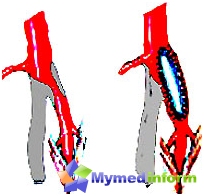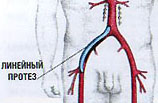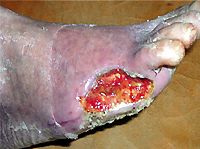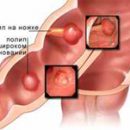The defeat of the arteries of the lower extremities often leads to the development of critical ischemia, gangrene and amputation. This forces to take intensive measures. Operations on the vessels restore blood flow, sufficient for the viability of legs and normal walking.
Content
Operations when defeating the arteries of the leg and hips
The disease of the arteries of the lower extremities, in addition to pain when walking, often lead to the development of critical ischemia and amputation. For the treatment of these lesions, the entire spectrum of vascular drugs is applied, but it is often necessary to perform reconstructive vascular operations to restore the blood circulation of the affected leg.
Depending on the damage of the arteries, several types of interventions are performed.
Profundoplasty
 With damage to the arteries in the upper third of the thigh to critical ischemia often leads the defeat of the deep artery of the thigh. Signs of critical limb ischemia are: constant pain in peace, requiring anesthesia for 2 weeks or more, trophic ulcer or gangrene of fingers or feet arising against the background of damage to the bottom limb arteries.
With damage to the arteries in the upper third of the thigh to critical ischemia often leads the defeat of the deep artery of the thigh. Signs of critical limb ischemia are: constant pain in peace, requiring anesthesia for 2 weeks or more, trophic ulcer or gangrene of fingers or feet arising against the background of damage to the bottom limb arteries.
The deep artery of the hip is narrowed by an atherosclerotic plaque and does not allow a sufficient amount of blood to penetrate the shini artery. In this case, the effective operation is profoundoplasty (Profude Lat. - deep).
Its meaning is to remove plaques from the deep artery and expanding it using a patch. In proportions, this operation leads to the elimination of critical ischemia in 90% of patients.
Risk of operation small (less than 1%). It is performed under local or spinal anesthesia. Hospitalization is required for 5-10 days.
By shunting his own veins
 With critical ischemia associated with the defeat of the fallated artery and the small arteries of the leg, the profoundoplasty will not lead to the elimination of critical ischemia.
With critical ischemia associated with the defeat of the fallated artery and the small arteries of the leg, the profoundoplasty will not lead to the elimination of critical ischemia.
In this case, it is necessary to resort to the shunting of its own veins. Vascular surgeons developed in detail the testimony and technique of execution of one of the most delicate operations — Fear-Tibial Shunting in Situ.
The meaning of this operation is to use the patient's own vein's own vein as a shunt, while the Vienna is not deleted, and the valves are cut using a special device.
The upper end of the vein is sewn into the pulsating femoral artery, the lower one is embedded in the flol-free or other elements below the arteries. This operation is often the last chance for patients who threaten amputation. It is very painstaking, technically complicated, performed under the increase. But with the right testimony and impeccable technical performance, this intervention allows you to save the village 85% «hopeless» Patients.
The risk at this operation does not exceed 3%. Anesthesia spinal or peridural anesthesia — Cross in the back. Hospitalization at least 10 days.
Lumbar sympathectomy
 If it is impossible to perform direct vascular operation in patients with damage to the arteries, lumbar sympathectomy is used.
If it is impossible to perform direct vascular operation in patients with damage to the arteries, lumbar sympathectomy is used.
The essence of this intervention is to remove the nerve node — Sympathetic Ganglia.
This node has a vasoconstrictor effect and its removal contributes to the expansion of viable arteries on the tibia and improves blood flow.
This operation is applied independently and in combination with direct vascular operations.
However, with independent use, it leads to an improvement only in 75% of patients. Operation is simple. The risk does not exceed 1%.
Other operations
Other operations such as a revascular osteotreep (mouth), the gauge transplantation on the shin and filling of the veins on the foot of arterial blood (arterialization of venous blood flow) are used in the most running cases when it is impossible to reconstruct the vessels. They lead to improving only 60% of patients.
Revascular osteotreep (mouth)
Revasculating osteotrepanation in Zusmanovich. The meaning of this operation is to create holes in the bones of the leg, in which the bone corn starts to develop and grow new vessels. This increases the total volume of the vascular bed and improves the blood supply to the limb. As an independent intervention, this operation is ineffective, but in combination with the microchunting of the lower leg, the remote results of the treatment of patients with critical ischemia can improve. The operation cannot be performed in the presence of purulent complications on the foot.
Selinic Gear Transplantation
The transplantation of a large gland to the limb with the help of microvascular anastomoses is designed for the formation of a new vascular network in the muscles of the lower leg, germinating from the jacket of the gland.
Filling veins at foot arterial blood (arterialization of venous blood flow)
The meaning of this operation lies in the start of blood flow in the veins of the feet, which should improve the nutrition of tissues.









